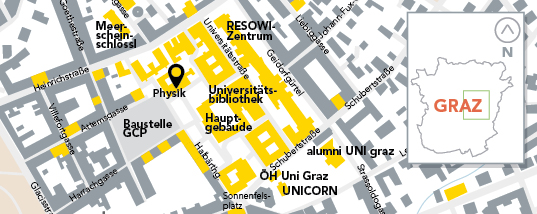Fachbereich Experimentalphysik
Eigenschaften von Materie und Licht
Von der Kontrolle einzelner Moleküle auf Oberflächen und der Maßschneiderung optischer Eigenschaften photonischer Nanopartikel über das Lenken und Leiten von Licht in optischen Schaltkreisen zur Erzeugung und Anwendung exotischer Lichtfelder: Im Fachbereich Experimentalphysik werden die fundamentalen Eigenschaften von Materie und Licht und deren Wechselwirkung untersucht.
Forschungsschwerpunkte
Optik von Nano- und Quantenmaterialien
Nanooptik
Oberflächen- und Grenzflächenphysik
Doctoral Academy NanoGraz
Leitung und Office Management
| E-Mail: Telefon:+43 316 380 - 8560 Web: https://physik.uni-graz.at/en/optics-of-nano-and-quantum-materials/ |
| E-Mail: Telefon:+43 316 380 - 5185 Öffnungszeiten:Mo - Fr: 10:00 - 12:00 Uhr (oder nach Vereinbarung) |
Isabella Lösch | E-Mail: Telefon:+43 316 380 - 8555 Öffnungszeiten:Mo - Fr: 8:00 - 12:00 Uhr |
| E-Mail: Telefon:+43 316 380 - 5255 Öffnungszeiten:Mo - Do: 9:00-15:00 Uhr, Fr: Homeoffice |
Kontakt
Fachbereich Experimentalphysik
8010 Graz, Austria
